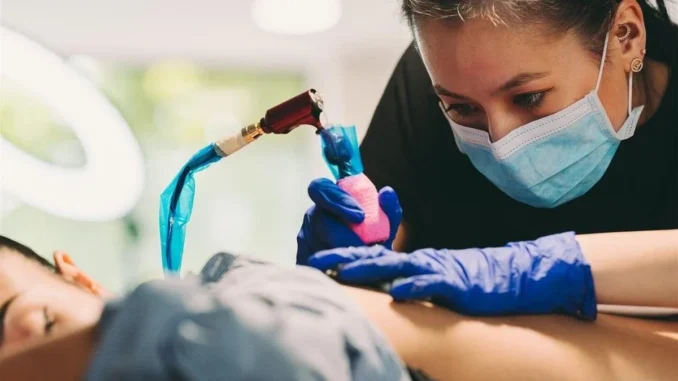
Numbing the Needle: Is Anesthesia Safe for Tattoos? Doctors Weigh In
In recent years, the tattoo industry has witnessed a dramatic evolution—not just in design complexity and artistry, but in how pain is managed during long sessions. Gone are the days when enduring the burn was simply part of body art. Now, a growing number of clients are opting for anesthesia—ranging from local numbing creams to general anesthesia—hoping to complete extensive tattoos in comfort. But as anesthesiologists caution, seeking anesthesia for tattoos is far from risk-free.
The Rise of Tattoo Anesthesia
Tattooing under anesthesia once seemed like a fringe idea. Now, it’s trending upward among those seeking extensive body art with minimal discomfort. Some high-end shops in Los Angeles and Miami even collaborate with board-certified anesthesiologists to sedate clients for marathon tattoo sessions—lasting several hours or even multiple days. One such session reportedly cost upwards of $30,000–35,000, as noted by veteran tattoo artist Romeo Lacoste (madeforthismoment.asahq.org, New York Post).
However, convenience comes at a steep price—not only financially, but in health risk. In January, Brazilian influencer Ricardo Godoi tragically died of cardiac arrest during a back tattoo administered under general anesthesia (People.com). His passing stunned the community and sparked urgent calls to evaluate anesthesia’s safety in non-surgical settings.
Anesthesiologists Speak: The Medical Perspective
Anesthesia Risks Never Relinquish
Dr. Ariel Jurmann, an anesthesiologist at North Shore University Hospital, emphasizes that no anesthesia is risk-free. Even mild sedation may obstruct breathing and trigger hypoxia, stroke, or cardiac arrest—risks that heighten if professionals lack appropriate training or environments (People.com).
ASA Safety Guidelines
The American Society of Anesthesiologists (ASA) stepped in with comprehensive guidance in June 2025. They stipulate that any sedation for tattoos must adhere to elective surgery protocols—preoperative evaluation, vital monitoring, post-anesthesia care, and adequate emergency infrastructure (asahq.org).
ASA President Dr. Donald Arnold stated:
“Choosing to undergo anesthesia for a tattoo comes with risks that go beyond the tattoo itself, and should be approached with serious consideration, like you would for any other elective surgical or cosmetic procedure” (asahq.org).
Pain Management Options: From Creams to General Anesthesia
1. Topical Anesthetics
- Commonly contain 4% or less lidocaine.
- Less effective on deeper skin layers; may alter skin texture—affecting tattoo quality and healing (Anatomy Tattoo).
2. Local Injections & Nerve Blocks
- Can numb specific body regions reliably.
- Requires medical professionals to ensure correct dosage, avoid systemic toxicity, and prevent nerve damage (madeforthismoment.asahq.org, WormholeTattoo).
3. Monitored IV Sedation
- Clients remain cushioned in deep relaxation but can breathe independently.
- Permits anesthesia professionals to monitor vital signs with full safety protocols (InkedMag).
4. General Anesthesia
- Clients are fully unconscious, requiring airway management and full monitoring.
- Suitable only in accredited medical settings—risks include respiratory suppression, cardiac changes, and rare but serious complications (People.com).
Weighing Benefits vs. Risks
Benefits
- Pain relief: Especially desirable for marathon sessions.
- Efficiency: Helps clients endure long sessions in fewer appointments.
- Focus: Enables detailed tattoo work without client movement.
Risks
- Serious complications: From airway obstruction to cardiac events—even with mild sedation (madeforthismoment.asahq.org, InkedMag, People.com).
- Skin healing issues: Numbing creams may obscure pain signals, leading to overworked skin or poor results (WormholeTattoo).
- Infection and monitoring lapses: Non-medical environments may lack sterile protocols or emergency preparedness (madeforthismoment.asahq.org).
Real-Life Cautionary Tales
- Ricardo Godoi: A painful loss reminding clients that anesthesia isn’t benign (People.com).
- Unregulated practices: Dr. Tiffany Moon criticized TikTok clips showing improper sedation setups lacking intubation and equipment (Reddit).
- Client experiences: One Reddit user reported dizziness and tingling after excessive lidocaine cream during tattoo removal—classic signs of toxicity .
Best Practices: What You Need to Know
✅ Only in Accredited Facilities
Anesthesia must be administered by board-certified anesthesiologists in medical or outpatient surgery settings, with full monitoring and emergency readiness (asahq.org).
✅ Thorough Pre-Procedure Screening
Complete medical history reviews, physical evaluations, and possible lab tests are essential—just like any elective medical procedure (asahq.org).
✅ Informed Consent and Post-Procedure Planning
Understand all risks (including airway issues, allergic reactions), and ensure someone accompanies you for recovery transport .
✅ Skilled Personnel and Safety Standards
Certified anesthesia providers must manage sedation, monitor vitals, and handle emergencies like allergic reactions or airway blockage .
The Experience vs. The Ethos
Tattoo Tradition vs. Trend
Some tattoo enthusiasts argue enduring pain is part of the ritual—“you need to earn your tattoo” (People.com). Others view pain-free inking as modern progress.
Cost vs. Outcome
Anesthesia can add tens of thousands of dollars to a tattoo’s price tag. The question becomes: is comfort worth the cost?
Tattoo Quality
Projects involving numbing may compromise skin texture, potentially affecting ink absorption and precision (WormholeTattoo).
Final Verdict: Is Anesthesia Safe for Tattoos?
Yes—but only when managed like surgery. When administered by qualified professionals in accredited settings, under thorough monitoring and proper consent, anesthesia can offer safe relief during tattoo sessions.
No—when used casually in tattoo parlors without medical oversight. Unregulated sedation, inadequate monitoring, and improper dosing elevate risk dramatically.
Before You Decide: A Safety Checklist
| ✅ Checkpoint | ✅ What to Confirm |
|---|---|
| Provider Credentials | Board-certified anesthesiologist administering anesthesia |
| Facility Standards | Accredited medical environment with full monitoring |
| Pre-Procedure Evaluation | Medical history, physical exam, lab work if needed |
| Understanding Risks | Allergy, airway, cardiac, and sedation complications |
| Post-Procedure Plan | Responsible escort and clear recovery instructions |
Final Takeaway
Getting tattooed under anesthesia is not inherently unsafe—but it must be approached with the seriousness of elective surgery. If comfort matters more than cost, time, or tradition, anesthesia offers a viable—but complex—option.
As Dr. Jurmann advised: “The risk is never zero.” And as ASA reinforced, this decision “should be approached with serious consideration” (asahq.org, People.com, asahq.org). Understanding the benefits, costs, and risks—alongside ensuring qualified professionals manage the process—is critical to making an informed and safe decision.
Leave a Reply